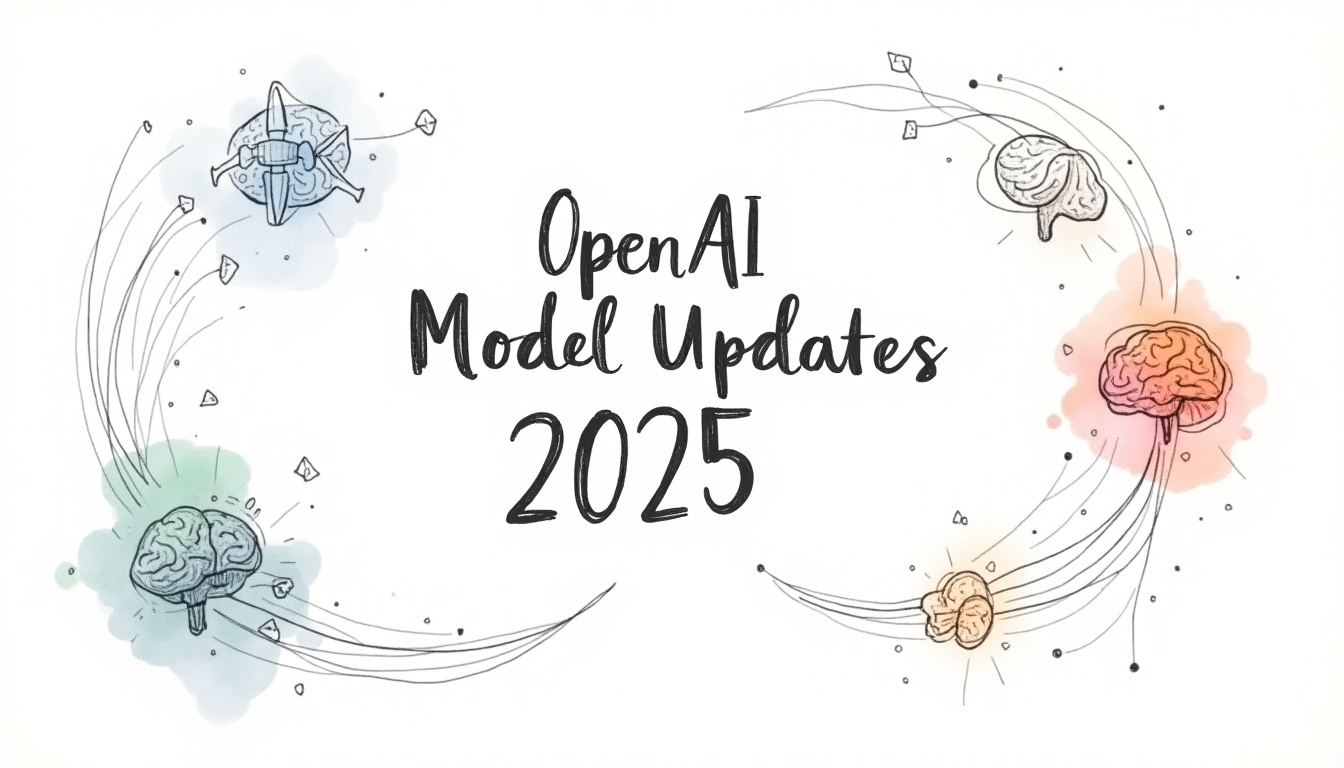
In 2025, OpenAI introduced several important updates to its AI models, starting with the GPT-4.1 family launched in April. This release included smaller versions like GPT-4.1 mini and nano, replacing the previous GPT-4.5 preview on the API and improving coding abilities by over 20%. Later that year, the o3 and o3-pro models arrived, achieving top benchmark performances. These new models handle very long contexts and follow instructions better while running more efficiently at lower costs. OpenAI also enhanced voice features for paid users and expanded Codex coding support to ChatGPT Plus subscribers. Plans for an open-source language model aimed to boost collaboration round out these updates.
Table of Contents
- Major AI Model Releases in 2025
- Performance Improvements in GPT-4.1 Models
- Expanded Context and Instruction Handling
- Updated Knowledge and Data Sources
- API Integration and New Product Features
- Open Source Plans and Collaboration Efforts
- Industry and Expert Feedback on New Models
- Public Reactions and Ethical Discussions
- Future Trends and AI Impact Across Sectors
- OpenAI’s Role in AI Safety and Policy
- Frequently Asked Questions
Major AI Model Releases in 2025

In April 2025, OpenAI introduced the GPT-4.1 family, which includes the GPT-4.1 mini and GPT-4.1 nano variants. These models replaced the earlier GPT-4.5 preview on the API and became the primary options for developers. Unlike previous releases, the GPT-4.1 family is only accessible via OpenAI’s API platform and not through standalone apps, offering flexibility for different use cases. Mid-year, OpenAI launched the o3 and o3-pro models, with the pro version targeting users who require higher performance. Both models performed exceptionally well on industry benchmarks like AIME 2024 and 2025, leading in accuracy and efficiency. Additionally, the o4-mini variant was released for lightweight applications, providing a balance of performance and resource efficiency. Paid users also saw improvements in voice AI through advanced voice mode updates, which enhanced naturalness and response speed. Throughout 2025, OpenAI expanded its lineup to serve a broad range of needs, from enterprise solutions to edge devices. These new releases emphasized a balance of power, speed, and cost to meet varied developer demands while focusing on modularity and accessibility for applications of different scales.
| Model | Release Date | Variants / Versions | Key Features | Availability | Performance Highlights |
|---|---|---|---|---|---|
| GPT-4.1 Family | April 2025 | GPT-4.1, GPT-4.1 mini, GPT-4.1 nano | Replaced GPT-4.5 preview; balanced power, speed, cost-effectiveness | OpenAI API only | Primary offering for developers |
| OpenAI o3 and o3-pro | Mid 2025 | o3, o3-pro (pro for higher performance) | Top performance benchmarks (AIME 2024, 2025) | API platform | Leading accuracy and efficiency |
| o4-mini variant | 2025 | o4-mini | Lightweight applications with competitive performance | API platform | Optimized for edge devices |
| Advanced voice mode updates | 2025 | N/A | Improved voice AI naturalness and response speed | Paid users only | Enhanced voice capabilities |
Performance Improvements in GPT-4.1 Models
The GPT-4.1 models mark a notable step forward in AI performance, especially in coding tasks where they outperform GPT-4o by 21% and GPT-4.5 by 27%. This improvement means developers can rely on GPT-4.1 for more accurate and efficient programming assistance, including handling complex, multi-step problems with fewer errors. Instruction following has also become more precise, allowing the models to better grasp user intent and deliver clearer, more relevant responses. One of the most significant upgrades is the massive expansion of the context window, now supporting up to 1 million tokens. This enables GPT-4.1 to maintain context over extremely long conversations or documents, which is useful for applications like drafting lengthy reports or managing extended workflows. Despite these enhancements, GPT-4.1 operates at a lower cost than GPT-4.5, offering better value for developers and businesses while improving response speed and reducing computational load. The model also demonstrates greater robustness when faced with ambiguous or conflicting instructions, increasing its reliability in real-world use. Beyond coding, GPT-4.1 shows notable gains in natural language understanding, summarization, and reasoning, making it a versatile tool across various domains. These combined advancements have led OpenAI to plan the retirement of GPT-4.5 API access by July 2025, encouraging users to transition to the more efficient and capable GPT-4.1 family.
- GPT-4.1 models improved coding task performance by 21% compared to GPT-4o and 27% compared to GPT-4.5, making them more capable for programming assistance.
- These models handle complex, multi-step programming problems with greater accuracy and fewer errors.
- Instruction following saw significant enhancements, allowing the models to better understand user intent and deliver more precise responses.
- The context window expanded dramatically, supporting up to 1 million tokens, far exceeding previous limits and enabling long, continuous conversations or documents.
- GPT-4.1 operates at a lower cost than GPT-4.5, providing better value for developers and enterprises.
- Due to these improvements, OpenAI planned to retire GPT-4.5 API access by July 2025.
- Efficiency gains allow faster response times and reduce computational resource requirements.
- The models’ ability to maintain context over long inputs supports more complex workflows and applications.
- GPT-4.1 models demonstrate improved robustness against ambiguous or contradictory instructions.
- Performance improvements also extend to natural language understanding, summarization, and reasoning tasks.
Expanded Context and Instruction Handling
The GPT-4.1 models introduced in 2025 feature a dramatically expanded context window, capable of processing up to 1 million tokens in a single interaction. This large capacity allows users to work with extensive documents, such as analyzing entire books, reviewing complex codebases in detail, or maintaining multi-turn conversations that retain memory across long sessions. Instruction handling has also become more refined; the models now better understand subtle and multi-step user requests, reducing the need for repeated clarifications. They manage context switches or interruptions with improved consistency, making interactions feel more natural and fluid. Users can provide detailed instructions alongside text and task parameters without losing coherence in the model’s responses. Additionally, GPT-4.1 adapts more effectively to individual user styles and preferences within a session, thanks to enhanced context retention. This also supports more reliable summarization and extraction of key points from lengthy inputs, which is particularly useful in professional or academic settings. Together, these improvements enable richer, more productive exchanges with AI, supporting a wider range of applications that demand deeper understanding and sustained focus over long interactions.
Updated Knowledge and Data Sources

The GPT-4.1 family features training data refreshed through June 2024, which helps keep the models current in fast-changing areas like technology, science, and news. OpenAI expanded the mix of data sources to include licensed content, publicly available information, and carefully curated datasets. This broader range improves the models’ understanding and reduces gaps in knowledge. Enhanced data cleaning and filtering methods were introduced to minimize bias and inaccuracies, resulting in more reliable outputs. These updates especially benefit specialized fields such as medicine, law, and engineering, where accuracy is crucial. Additionally, the models better reflect recent discoveries and developments, making them more useful for professional and research purposes. OpenAI also integrated improved techniques for retrieving knowledge and fact-checking during response generation, which helps lower hallucination rates while maintaining a balance between factual accuracy and creative generation. The refreshed data supports better generalization across various topics and significantly enhances performance in multilingual and cross-cultural contexts, allowing the models to serve a more diverse user base effectively.
API Integration and New Product Features

OpenAI’s 2025 model updates bring significant enhancements to API integration, offering developers seamless access to the latest AI capabilities. The new GPT-4.1 family is fully integrated into the API, enabling smarter AI agents that assist with task automation and decision-making. Since June 2025, Codex has been expanded to ChatGPT Plus users, improving coding support directly within chat, which helps developers troubleshoot and write code more efficiently. The API now supports fine-tuning and customization options for enterprise clients, allowing models to be tailored to specific business data and workflows. OpenAI also introduced new API endpoints to handle voice mode features and multi-modal inputs, making it easier for developers to build applications that combine text, voice, and images. Improvements in rate limiting, usage tracking, and flexible pricing plans address diverse customer needs, from individual developers to large organizations. Additionally, the expanded context window supports up to one million tokens, allowing applications to handle longer conversations and complex instructions without losing track. Enhanced documentation and sample code simplify adoption of these features, while broader integration with third-party platforms supports improved workflow automation. Overall, product updates focus on usability, reliability, and scalability to meet the demands of a wide range of users.
Open Source Plans and Collaboration Efforts

OpenAI announced plans to release its first open-source language model in summer 2025, aiming to promote wider collaboration in AI research. This open-source release is designed to serve as a transparent baseline that encourages innovation and experimentation across the community. OpenAI is inviting contributions from researchers and developers to help improve model architecture and safety features. Alongside the model release, OpenAI is developing open benchmarks and evaluation tools to support consistent and fair assessment of AI performance. The open-source model is intended to support a variety of use cases, including academic research, education, and specialized applications that benefit from customizable AI solutions. OpenAI emphasizes responsible use by providing guidelines and safety protocols to minimize risks of misuse or harmful outcomes. To strengthen these efforts, OpenAI is partnering with academic institutions and industry leaders, fostering collaborations that align AI development with societal needs. These initiatives complement OpenAI’s proprietary offerings by promoting shared knowledge and innovation within a global AI ecosystem.
Industry and Expert Feedback on New Models
Industry analysts widely recognize the GPT-4.1 release as a meaningful step forward in AI model capabilities and cost efficiency. Experts particularly point to the model’s stronger coding abilities, improved context handling, and enhanced instruction following as key factors setting it apart from previous versions. These improvements have encouraged increased competition and innovation among AI developers, driving the sector to explore more advanced and efficient solutions. However, some experts express caution about the rapid pace of adoption, emphasizing the need for robust safety measures to accompany the technical progress. Ethical considerations remain a central topic, with researchers underscoring the importance of monitoring potential biases and misuse as these models become more powerful. OpenAI’s transparency in sharing performance data and future plans has been well received, fostering trust within the developer community. Feedback from developers highlights satisfaction with the new API features and detailed documentation, which have made integration smoother and more productive. AI ethics specialists continue to advocate for ongoing vigilance to ensure responsible deployment. Overall, the new models are viewed as a solid foundation for next-generation AI applications across industries, balancing optimism about their capabilities with a clear call for continued responsibility and ethical oversight.
Public Reactions and Ethical Discussions
Public conversations on platforms like X and Reddit reveal a mix of enthusiasm and caution regarding OpenAI’s 2025 model updates. Many users highlight practical benefits, such as improved AI assistance in writing, coding, and research, which have made daily tasks more efficient. At the same time, ethical discussions remain active, focusing on AI safety, privacy concerns, and the potential impact on jobs across different industries. There is ongoing debate about the best governance frameworks to ensure AI is used fairly and responsibly. Some community members express worries about AI-generated misinformation and emphasize the need for reliable verification tools. OpenAI’s transparent communication about model limitations and safety measures is appreciated, although the public often calls for even greater openness. Discussions also extend to AI’s role in education, creativity, and content moderation, reflecting diverse perspectives on how AI should be integrated into society. Importantly, the feedback collected through these dialogues influences OpenAI’s priorities in updating features and addressing ethical challenges. Overall, ethical dialogue remains a key part of the AI rollout, shaping how these technologies evolve and are adopted in the future.
Future Trends and AI Impact Across Sectors

AI advancements in 2025 are set to reshape many industries by enabling smarter, more efficient solutions. In healthcare, AI-driven diagnostics and personalized treatment plans are expected to enhance patient outcomes and speed up medical research. Autonomous systems will benefit from improved AI decision-making, making self-driving vehicles and robotics safer and more reliable. Software development workflows will become more streamlined with AI-assisted coding and testing tools that reduce errors and accelerate delivery. Education may see a shift toward personalized learning experiences powered by context-aware AI tutors that adapt to individual student needs. The expanded token capacity of new models allows handling of long-form content, opening doors for complex applications in legal analysis, scientific research, and creative projects that require deep understanding over extended text. As AI integrates more deeply with IoT and edge computing, real-time data processing and local AI functionality will improve, supporting smarter environments and devices. Regulatory efforts are growing to ensure AI innovation aligns with safety and societal values, emphasizing transparency and ethical use. Cross-sector collaboration will play a crucial role in responsibly unlocking AI’s potential, combining expertise from technology, policy, and domain-specific fields. OpenAI’s focus on safety and transparent development supports this balanced approach, aiming for AI that is useful, fair, and inclusive across diverse applications.
OpenAI’s Role in AI Safety and Policy
OpenAI maintains a strong focus on AI safety throughout the development of its models, ensuring that safety measures are integrated at every stage. This includes creating robust guardrails designed to reduce harmful outputs and prevent misuse. The organization actively collaborates with policymakers to help shape regulations that balance innovation with societal protection. Transparency is a key part of OpenAI’s approach, demonstrated through regular updates and detailed transparency reports that build public trust and accountability. Beyond national efforts, OpenAI works with international bodies to develop global safety standards for AI, recognizing that the technology’s impact crosses borders. To address bias, OpenAI invests in tools and processes that detect and mitigate unfair or harmful patterns in AI outputs. The company also advocates for responsible AI deployment practices across industries, encouraging careful consideration of AI’s societal effects. Educational initiatives supported by OpenAI aim to raise awareness about both the risks and benefits of AI, helping users and developers make informed decisions. Central to OpenAI’s policy work is aligning AI progress with human values and broader societal needs, creating a framework that supports safe and ethical innovation.
Frequently Asked Questions
1. What are the main improvements OpenAI made to its AI models in 2025?
In 2025, OpenAI focused on enhancing model accuracy, reducing bias, and improving context understanding. Updates included better multi-turn conversation handling and faster response generation, aiming to make interactions more natural and reliable.
2. How do 2025 updates affect the way AI understands and generates language?
The 2025 updates improved the AI’s ability to grasp nuances and context across longer conversations. This means the models generate responses that are more coherent, context-aware, and aligned with the user’s intent over extended interactions.
3. What new features were introduced to OpenAI models in 2025 to support developers?
OpenAI introduced improved APIs with enhanced customization options, better documentation, and expanded support for different programming languages. There were also new tools for fine-tuning models and monitoring AI performance more effectively in real time.
4. How have safety and ethical considerations evolved in OpenAI’s 2025 model updates?
In 2025, OpenAI strengthened safety measures by integrating more robust content filtering and bias mitigation techniques. The updates included improved guardrails to minimize harmful outputs while maintaining useful and informative responses.
5. Can the 2025 OpenAI model updates handle multi-modal inputs or just text?
The 2025 updates introduced expanded multi-modal capabilities, allowing models to process not only text but also images and audio inputs. This broadens the range of applications and enables richer, more interactive user experiences.
TL;DR In 2025, OpenAI released the GPT-4.1 family and new models like o3 and o4-mini, offering better performance, especially in coding and long-context handling, at lower costs. Updated knowledge bases and enhanced API features improved user experience and integration. OpenAI also plans its first open-source language model release. The industry praised these advancements for driving innovation while emphasizing responsible AI deployment. Public reaction mixed excitement with ethical concerns. Looking ahead, these updates are expected to impact multiple sectors with ongoing focus on safety and policy.
Comments are closed